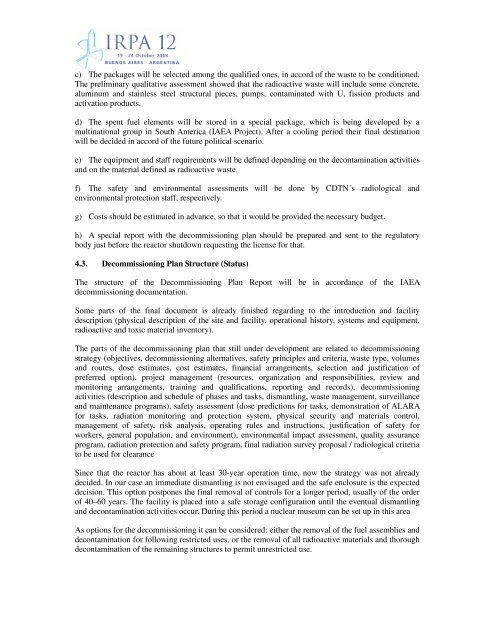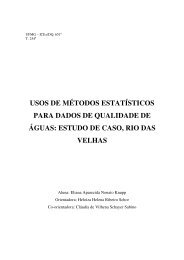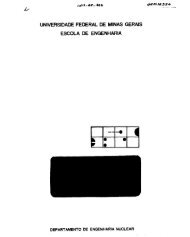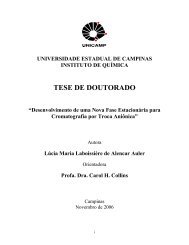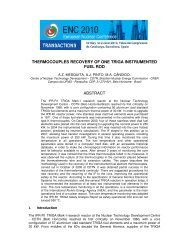ipr-r1 triga research reactor decommissioning plan - CDTN
ipr-r1 triga research reactor decommissioning plan - CDTN
ipr-r1 triga research reactor decommissioning plan - CDTN
Create successful ePaper yourself
Turn your PDF publications into a flip-book with our unique Google optimized e-Paper software.
c) The packages will be selected among the qualified ones, in accord of the waste to be conditioned.<br />
The preliminary qualitative assessment showed that the radioactive waste will include some concrete,<br />
aluminum and stainless steel structural pieces, pumps, contaminated with U, fission products and<br />
activation products.<br />
d) The spent fuel elements will be stored in a special package, which is being developed by a<br />
multinational group in South America (IAEA Project). After a cooling period their final destination<br />
will be decided in accord of the future political scenario.<br />
e) The equipment and staff requirements will be defined depending on the decontamination activities<br />
and on the material defined as radioactive waste.<br />
f) The safety and environmental assessments will be done by <strong>CDTN</strong>´s radiological and<br />
environmental protection staff, respectively.<br />
g) Costs should be estimated in advance, so that it would be provided the necessary budget.<br />
h) A special report with the <strong>decommissioning</strong> <strong>plan</strong> should be prepared and sent to the regulatory<br />
body just before the <strong>reactor</strong> shutdown requesting the license for that.<br />
4.3. Decommissioning Plan Structure (Status)<br />
The structure of the Decommissioning Plan Report will be in accordance of the IAEA<br />
<strong>decommissioning</strong> documentation.<br />
Some parts of the final document is already finished regarding to the introduction and facility<br />
description (physical description of the site and facility, operational history, systems and equipment,<br />
radioactive and toxic material inventory).<br />
The parts of the <strong>decommissioning</strong> <strong>plan</strong> that still under development are related to <strong>decommissioning</strong><br />
strategy (objectives, <strong>decommissioning</strong> alternatives, safety principles and criteria, waste type, volumes<br />
and routes, dose estimates, cost estimates, financial arrangements, selection and justification of<br />
preferred option), project management (resources, organization and responsibilities, review and<br />
monitoring arrangements, training and qualifications, reporting and records), <strong>decommissioning</strong><br />
activities (description and schedule of phases and tasks, dismantling, waste management, surveillance<br />
and maintenance programs), safety assessment (dose predictions for tasks, demonstration of ALARA<br />
for tasks, radiation monitoring and protection system, physical security and materials control,<br />
management of safety, risk analysis, operating rules and instructions, justification of safety for<br />
workers, general population, and environment), environmental impact assessment, quality assurance<br />
program, radiation protection and safety program, final radiation survey proposal / radiological criteria<br />
to be used for clearance<br />
Since that the <strong>reactor</strong> has about at least 30-year operation time, now the strategy was not already<br />
decided. In our case an immediate dismantling is not envisaged and the safe enclosure is the expected<br />
decision. This option postpones the final removal of controls for a longer period, usually of the order<br />
of 40–60 years. The facility is placed into a safe storage configuration until the eventual dismantling<br />
and decontamination activities occur. During this period a nuclear museum can be set up in this area<br />
As options for the <strong>decommissioning</strong> it can be considered: either the removal of the fuel assemblies and<br />
decontamination for following restricted uses, or the removal of all radioactive materials and thorough<br />
decontamination of the remaining structures to permit unrestricted use.


